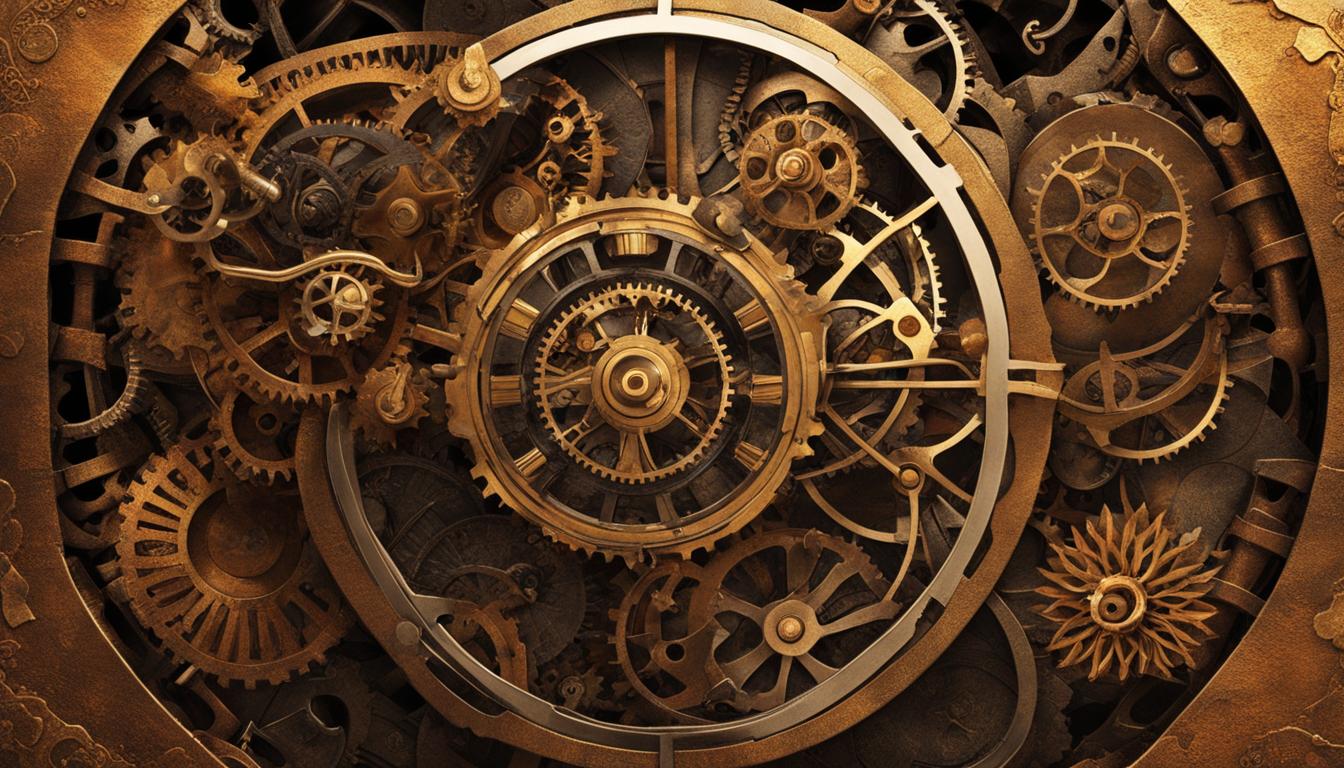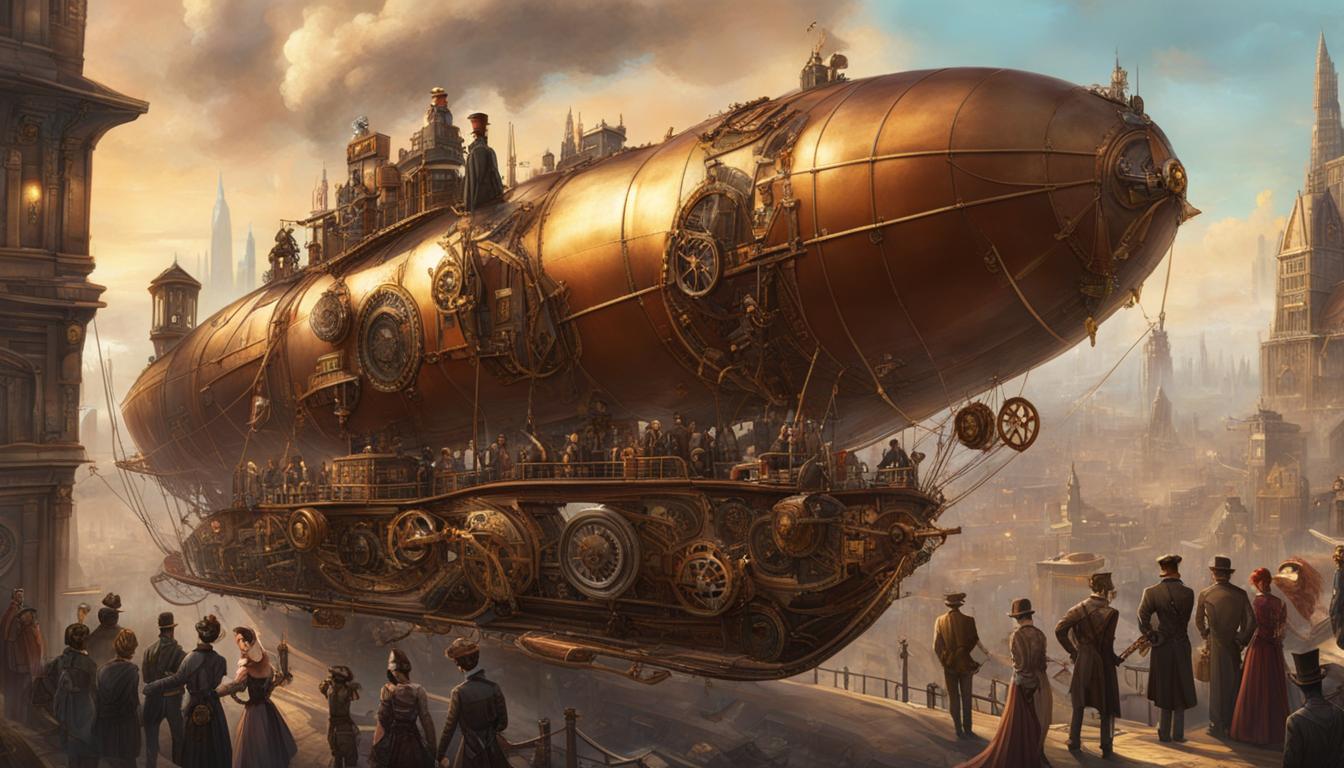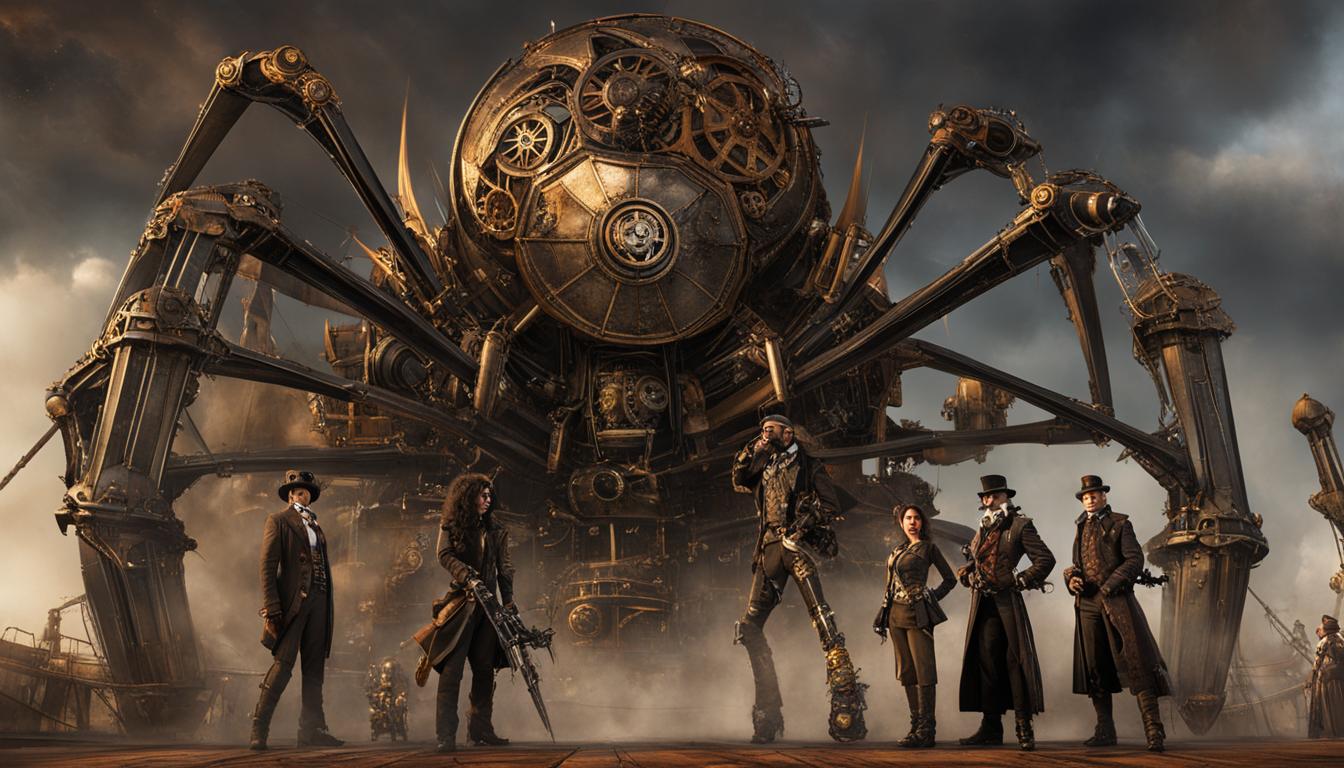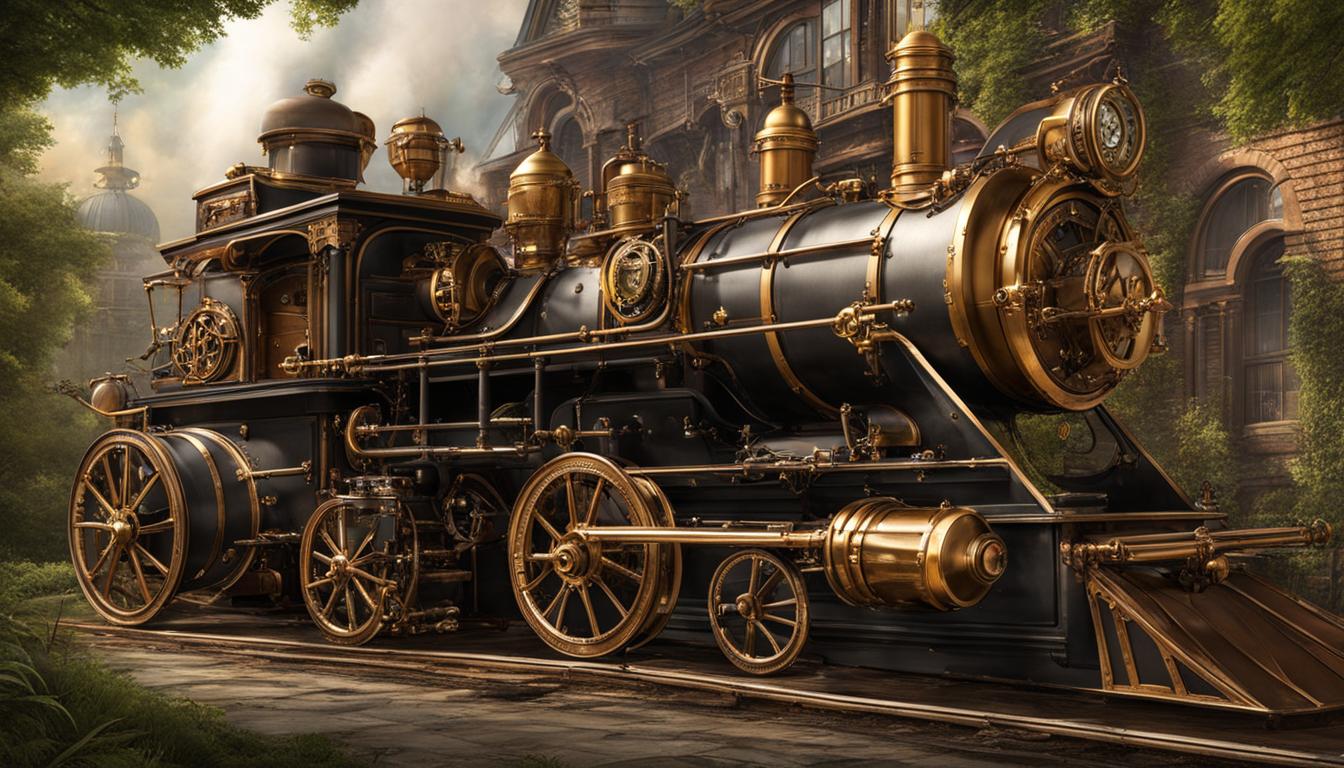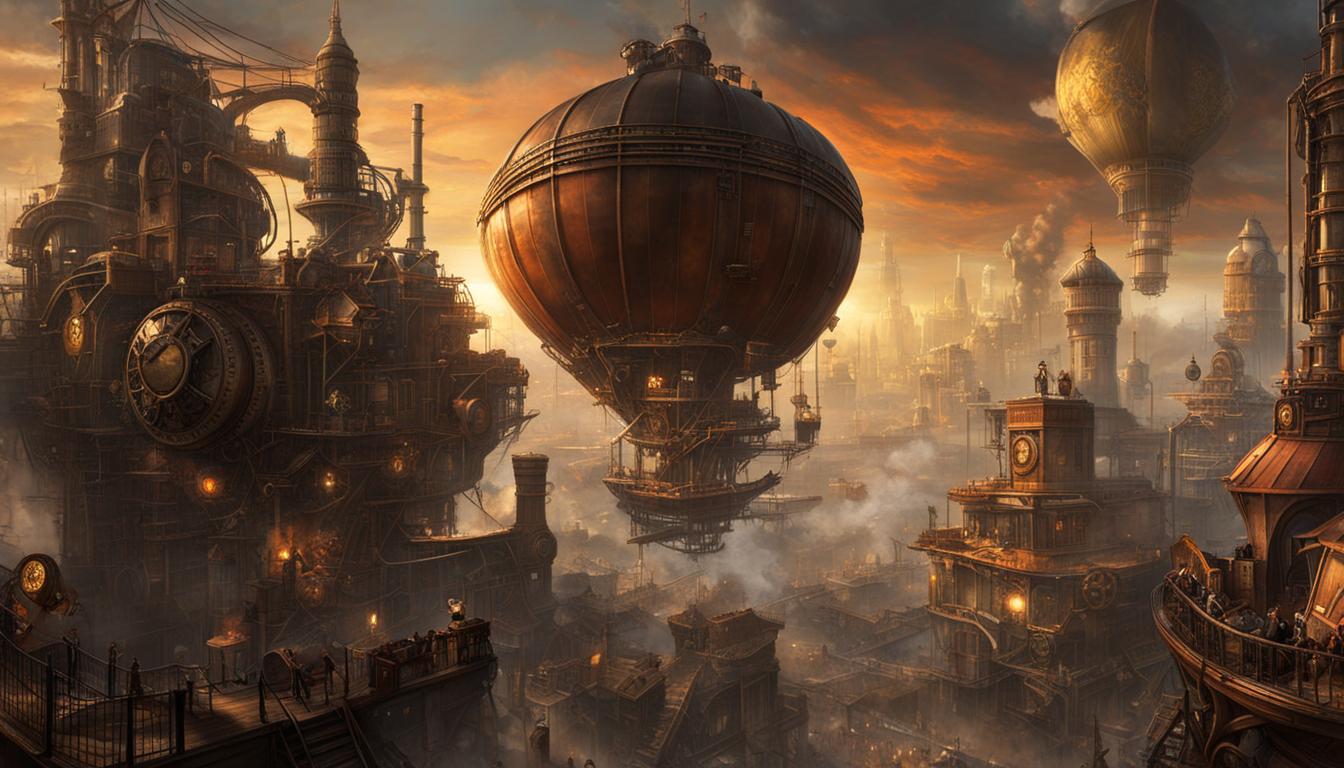Steampunk art, with its fusion of 19th-century aesthetics and science fiction elements, holds a mysterious allure that goes beyond its visual appeal. Beneath the surface of gears, clockwork mechanisms, and Victorian fashion lies a profound world of philosophical symbolism waiting to be deciphered. In this article, we embark on a journey to unravel the intricate meanings hidden within steampunk artworks and explore the philosophical motifs they represent.
Key Takeaways:
- Steampunk art combines 19th-century aesthetics with science fiction elements.
- There is hidden philosophical symbolism within steampunk artworks.
- The visual language of steampunk art can convey deeper meanings.
- Steampunk art reflects societal views and engages in philosophical debates.
- Steampunk sculptures, fashion, literature, and film all contribute to the rich tapestry of philosophical narratives.
Exploring the Visual Language of Steampunk Art
Steampunk artistry encompasses a wide range of visual forms, including sculptures, fashion, and designs. By analyzing the aesthetics and symbolism within these artworks, we can identify the narrative elements that convey deeper meanings. Elements such as gears, clockwork mechanisms, and Victorian-inspired fashion can symbolize themes of progress, technological advancements, and a longing for the past. Through this exploration, we unlock the visual language of steampunk art and uncover the philosophical narratives it seeks to communicate.
Deciphering Steampunk Artistry
Steampunk art embodies a unique blend of historical elements and futuristic imagination, creating a visual language that is rich in symbolism and meaning. The use of gears and clockwork mechanisms, for example, represents the intricate workings of a society driven by technological progress. These visual elements not only accentuate the aesthetics of steampunk art but also offer deeper insights into the philosophical underpinnings of the genre.
“Steampunk art is like a time machine, transporting us to a Victorian era where steam-powered machinery reigns supreme. But beneath its nostalgic exterior lies a deeper layer of symbolism, reflecting our fascination with progress, our longing for the past, and our complex relationship with technology.”
Furthermore, the incorporation of Victorian-inspired fashion in steampunk art signifies a desire to revisit a bygone era. This amalgamation of past and future aesthetics prompts contemplation on the impact of technological advancements and the balance between progress and tradition. Ultimately, by delving into the visual language of steampunk art, we can decipher its artistry and uncover the profound philosophical meanings embedded within.
| Visual Elements | Symbolism |
|---|---|
| Gears and clockwork mechanisms | Technological progress |
| Victorian-inspired fashion | Longing for the past, balance between progress and tradition |
| Industrial materials | Transformation and adaptation |
| Steampunk accessories | Individuality and self-expression |
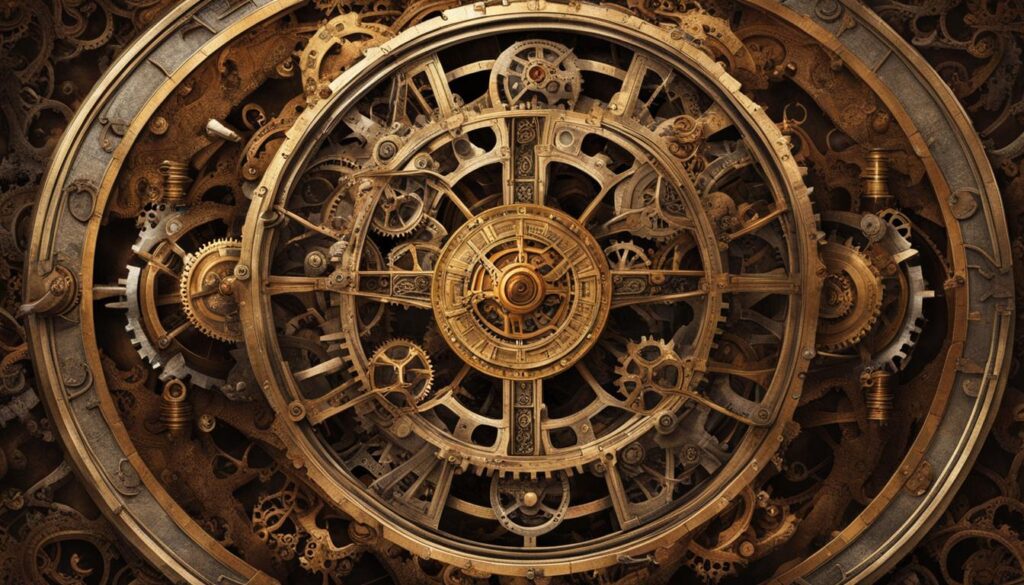
In summary, exploring the visual language of steampunk art allows us to delve into the deeper meanings and philosophical narratives it conveys. The symbolism embedded within the aesthetics, such as gears, clockwork mechanisms, and Victorian-inspired fashion, provides insights into themes of progress, technological advancements, and a longing for the past. By deciphering the artistry of steampunk, we unveil a world where art and philosophy intertwine, inviting us to question our relationship with technology and reflect on the impact of progress on society.
Examining the Socio-Cultural Context of Steampunk Art
Steampunk art is more than just an aesthetic choice; it reflects and comments on the societal views of the time it represents. By examining the symbols and motifs embedded in steampunk designs, we can gain insights into the values and beliefs of the era in which it emerged. The juxtaposition of advanced technology and Victorian aesthetics in steampunk art represents the tension between progress and tradition, offering a unique lens through which we can analyze and understand the philosophical underpinnings of this captivating genre.
One symbolic representation commonly found in steampunk art is the fusion of machinery and organic elements. This interplay between mechanical and natural elements reflects society’s relationship with technology and raises philosophical questions about the blurring boundaries between man and machine. Steampunk artists use these symbols to engage in philosophical debates surrounding the impact of technological advancements on human existence and identity.
“Steampunk artwork serves as a visual commentary on societal views and values, inviting viewers to question the consequences of progress and reflect on the balance between tradition and innovation.” – Renowned steampunk artist
Furthermore, steampunk art often draws inspiration from the historical context in which it was created. By examining the cultural and historical events of the time, we can better understand the deeper meanings embedded within the artistic visuals. For example, the Victorian era, with its strict societal structure and rapid industrialization, serves as a backdrop for steampunk art to explore themes of individuality, social hierarchy, and the consequences of unchecked technological growth.
| Symbol | Meaning |
|---|---|
| Gears and Clockwork Mechanisms | Represents progress and technological advancements |
| Victorian-Inspired Fashion | Symbolizes nostalgia for the past and a longing for a simpler time |
| Airships and Flying Machines | Signifies the human desire to conquer the skies and explore new horizons |
Steampunk artwork reflects and comments on the views and values of the society in which it is created. Through the symbolic representation of advanced technology, Victorian aesthetics, and historical context, steampunk artists engage in philosophical debates and invite viewers to contemplate the consequences of progress. By examining the socio-cultural context and symbolism within steampunk designs, we gain a deeper understanding of the philosophical motifs that underpin this fascinating genre.
Unraveling the Metaphorical Aspects of Steampunk Fashion
Steampunk fashion is a captivating blend of Victorian aesthetics and futuristic elements that goes beyond mere style. It serves as a medium for symbolic representation, conveying deep meanings and philosophical narratives. The unique combination of corsets, goggles, and other accessories within steampunk fashion provides a rich tapestry of metaphors and symbolism.
One of the metaphorical aspects commonly observed in steampunk fashion is the use of corsets. These garments, which were historically associated with restriction and control, take on a new meaning in the context of steampunk. They represent both physical and metaphorical constraints, symbolizing the societal norms and expectations that individuals strive to break free from.
“Steampunk fashion allows individuals to explore their desire for freedom and self-expression while still embracing elements of the past,” explains fashion historian Dr. Amelia Evans. “The corsets in steampunk fashion act as a visual metaphor for the struggle between societal constraints and personal liberation.”
Another significant element in steampunk fashion is the ubiquitous presence of goggles. These accessories, reminiscent of industrial machinery and scientific exploration, signify the steampunk ethos of vision and innovation. They represent the desire to see the world from a new perspective, to explore the possibilities that lie beyond the limitations of conventional thinking.
Steampunk fashion is not merely an aesthetic choice; it is a form of artistic expression layered with symbolic meaning. The corsets, goggles, and other accessories within steampunk fashion intertwine with philosophical motifs, reflecting the desires, struggles, and aspirations of individuals seeking to transcend societal norms and embrace a world of imagination and possibility.
Table: Symbolic Representations in Steampunk Fashion
| Symbol | Meaning |
|---|---|
| Corsets | Metaphor for societal constraints and personal liberation |
| Goggles | Symbol of vision and innovation |
| Accessories | Representations of individuality and exploration |
The symbolic representations in steampunk fashion are not limited to corsets and goggles; each accessory and garment holds its own unique significance. The interplay of these elements creates a visual language that speaks to the philosophical narratives embedded within the steampunk genre. By unraveling these metaphors, we can gain a deeper understanding of the complexity and depth of symbolism in steampunk fashion and its contribution to the overall visual arts associated with the genre.
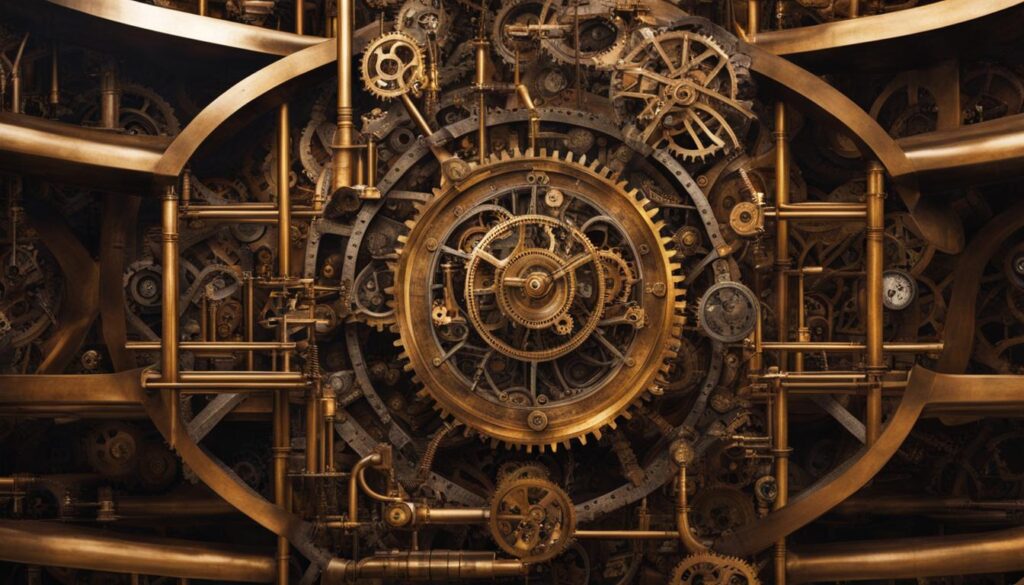
“Steampunk sculptures provide a fascinating exploration of existence, identity, and the intertwining of nature and technology. The intricate details and symbolism within these artworks challenge our perceptions and ignite philosophical debates. They serve as a visual representation of the complexities of the human experience in a world influenced by industrialization and progress.”
An additional recurring theme in steampunk sculptures is the exploration of the human relationship with machines. These sculptures often depict intricate mechanical contraptions, serving as a commentary on the consequences of technological advancements. They highlight the symbiotic yet precarious nature of this relationship, raising questions about the impact of technology on society and the potential loss of human connection.
Table: Comparative Analysis of Philosophical Motifs in Steampunk Sculptures
| Philosophical Motif | Symbolism |
|---|---|
| Existence | Juxtaposition of machinery and natural elements; exploration of the essence of being |
| Identity | Depiction of hybrid creatures and mechanical prosthetics; contemplation of the integration of technology into the human experience |
| Human-Machine Relationship | Representation of intricate machines; reflection on the consequences of technological advancements and their impact on society |
Steampunk sculptures offer us a glimpse into a world where philosophical debates are given shape and form. They challenge our perceptions, ignite thought-provoking discussions, and invite us to consider the profound questions that underpin human existence. By analyzing the aesthetics and symbolism within these sculptures, we gain a deeper understanding of the philosophical motifs inherent in the steampunk genre.
The Interplay Between Art and Philosophy in Steampunk Literature and Film
Steampunk art extends beyond visual forms and encompasses literature and film, creating a captivating interplay between art and philosophy. The narratives within steampunk stories and movies often reflect philosophical debates and ideas, inviting readers and viewers to delve into deeper contemplation.
“Steampunk offers a unique platform to explore themes of individuality, societal structure, and the consequences of technological advancements,” says renowned steampunk artist, Victoria Chambers. “Through the lens of steampunk, we can examine the human condition and our relationship with machines in a thought-provoking way.”
Steampunk literature, such as the classic novel “The Difference Engine” by William Gibson and Bruce Sterling, raises questions about the impact of technology on society and personal identity. By presenting an alternative version of history with advanced machinery, these works prompt readers to contemplate the ethical dilemmas and philosophical implications of a world shaped by steam-powered innovation.
In film, steampunk aesthetics and narratives have been brought to life in movies like “Wild Wild West” and “The League of Extraordinary Gentlemen.” These films use the steampunk genre as a backdrop to explore larger philosophical concepts of power, morality, and the consequences of unchecked progress. By intertwining art and philosophy, steampunk literature and film provide a rich and engaging experience for both creators and audiences alike.
The Influence of Cultural and Historical Context on Steampunk Symbolism
Steampunk art is not only influenced by the era it represents but also by the cultural and historical context in which it was created. Cultural and historical events shape the symbols and metaphors used in steampunk art, adding layers of meaning and depth.
- The Industrial Revolution: The rise of steam-powered machinery during the Industrial Revolution serves as a primary source of inspiration for steampunk art. The symbolism of gears, clockwork mechanisms, and steam engines represents the transformative power of technology and its impact on society.
- Victorian Era: The Victorian era’s strict societal norms and class structures are often portrayed in steampunk art, reflecting the tension between progress and tradition. The fashion, architecture, and etiquette of the time provide a rich visual tapestry for artists to explore philosophical themes.
- Post-Apocalyptic Imagery: Steampunk art sometimes incorporates elements of post-apocalyptic imagery, drawing on the fear of societal collapse and the desire for resilience in the face of adversity. These symbols convey philosophical narratives of survival, human ingenuity, and the potential consequences of unchecked human hubris.
By exploring the cultural and historical context of the steampunk movement, we can gain a clearer understanding of the deeper meanings embedded within the artistic visuals. This understanding allows us to further decode the philosophical symbolism in steampunk art, connecting the dots between art, philosophy, and the world in which it exists.
| Symbolism | Meaning |
|---|---|
| Gears and Clockwork Mechanisms | Represents the transformative power of technology and progress |
| Steam Engines | Symbolizes the industrial revolution and its impact on society |
| Victorian Fashion | Evoke societal norms and reflect societal structures |
| Post-Apocalyptic Imagery | Conveys themes of survival, resilience, and the consequences of human actions |
The Influence of Cultural and Historical Context on Steampunk Symbolism
Steampunk art is deeply intertwined with the cultural and historical context in which it emerged, shaping the symbolic representations and deeper meanings within the genre. The fusion of Victorian aesthetics and futuristic elements reflects both the nostalgia for the past and the fascination with technological progress. By exploring the cultural and historical influences on steampunk symbolism, we can gain a deeper understanding of the philosophical narratives embedded within these artworks.
The Cultural Influences
Steampunk art draws inspiration from a range of cultural influences, including literature, art movements, and societal trends. The works of authors such as Jules Verne and H.G. Wells, who pioneered the science fiction genre, laid the foundation for the imaginative world of steampunk. The Industrial Revolution, with its profound impact on society and technology, also plays a significant role in shaping steampunk symbolism. The juxtaposition of steam-powered machinery and Victorian aesthetics reflects the cultural fascination with progress and the tension between tradition and innovation.
Moreover, the resurgence of steampunk in the late 20th century was fueled by the subcultural movements and countercultural ideologies, such as the DIY (do-it-yourself) ethos and the punk aesthetic. These influences added a rebellious and individualistic dimension to steampunk art, challenging established norms and offering alternative perspectives on society and technology.
The Historical Context
To fully grasp the symbolism within steampunk art, we must also consider the historical context in which it was created. The Victorian era, known for its rigid social structure and technological advancements, serves as a backdrop for many steampunk narratives. The themes of class struggle, colonization, and industrialization prevalent during the Victorian era are often explored and reimagined in the world of steampunk.
Furthermore, steampunk symbolism can be influenced by specific historical events. For example, the aftermath of World War I and World War II, with their devastating effects on society and technology, can be seen reflected in steampunk artworks that depict a dystopian or post-apocalyptic world. By examining the historical context of the steampunk movement, we can uncover the layers of meaning embedded within these artworks and appreciate the depth of their philosophical symbolism.
| Cultural Influences | Historical Context |
|---|---|
| – Literature of Jules Verne and H.G. Wells | – Victorian era and its social structure |
| – Art movements and countercultural ideologies | – Technological advancements |
| – Societal trends and subcultural movements | – Post-war effects and dystopian themes |
By exploring the cultural and historical context of the steampunk movement, we can unravel the intricate layers of symbolism and deeper meanings within these artworks. The fusion of past and future, tradition and innovation, reflects the ongoing philosophical debates and societal values. Steampunk art serves as a powerful medium for exploring these complex ideas and engaging in thoughtful discussions about the interplay between art, philosophy, and society.
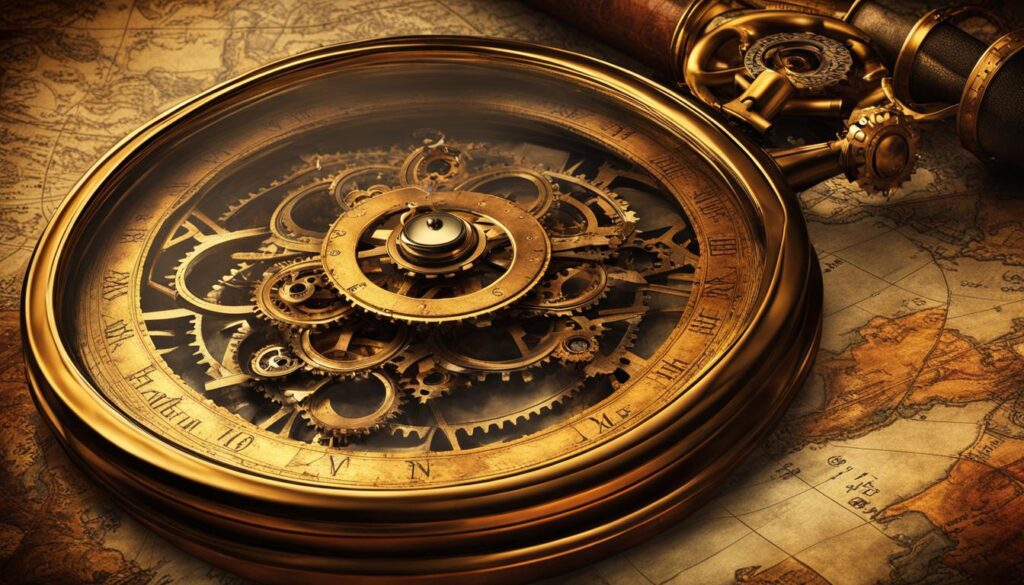
“Steampunk art is not merely a visual aesthetic but a reflection of the cultural and historical forces that shape our world. By decoding the symbolism within steampunk artworks, we can delve into the philosophical narratives and gain a deeper appreciation for this captivating genre.”
Conclusion
In the captivating world of steampunk art, there lies a wealth of philosophical symbolism waiting to be decoded. By analyzing the aesthetics and symbolism within steampunk artworks, we can delve into the deeper meanings and philosophical narratives they convey. Whether it’s deciphering the visual language of steampunk, unraveling the metaphorical aspects of fashion and sculptures, or exploring the socio-cultural and historical context, each artistic form within the genre offers unique insights into philosophical debates and concepts.
From the intricate mechanisms of steampunk sculptures to the symbolic representation of societal views in designs, the interplay between art and philosophy is evident throughout the steampunk movement. The genre serves as a reflection of our fascination with progress, technology, and the tension between tradition and advancement. Through this exploration, we gain a deeper appreciation for the complexity of steampunk’s philosophical symbolism and the thought-provoking ideas it embodies.
Decoding the philosophical symbolism in steampunk art is a journey that invites us to question our own beliefs and engage in philosophical debates. It challenges us to reflect on our relationship with technology, our understanding of progress, and our longing for nostalgia. By analyzing the aesthetics and symbolism, we can uncover the hidden meanings and engage in a deeper understanding of the ideas that underpin steampunk art.
So, venture into the world of steampunk art, embrace the mystery and intrigue it offers, and allow yourself to be captivated by the philosophical symbolism hidden within its intricate designs. Through analyzing the steampunk aesthetics and symbolism, we embark on a journey of intellectual discovery, uncovering the profound philosophical narratives that lie beneath the surface.
FAQ
What is steampunk art?
Steampunk art is a genre that combines the aesthetics of 19th-century steam-powered machinery with elements of science fiction and fantasy.
What are the symbolic representations in steampunk art?
Steampunk art uses elements such as gears, clockwork mechanisms, and Victorian-inspired fashion to symbolize themes of progress, technological advancements, and a longing for the past.
What philosophical debates are explored in steampunk art?
Steampunk art engages in philosophical debates surrounding progress vs. tradition, the interplay between nature and technology, and the consequences of technological advancements.
How does the socio-cultural context influence steampunk art?
Steampunk art reflects societal views and values of the era it represents, using symbols and motifs to depict tensions between societal structures, individuality, and the impact of advanced technology.
What are the metaphorical aspects of steampunk fashion?
Steampunk fashion uses corsets, goggles, and other accessories to convey ideas of constraint, vision, and exploration, adding to the overall symbolism in the visual arts associated with the genre.
What philosophical narratives do steampunk sculptures convey?
Steampunk sculptures explore themes such as existence, identity, and the human relationship with machines through the juxtaposition of mechanical and organic elements, inviting philosophical contemplation.
How does steampunk literature and film reflect philosophical debates?
Steampunk stories and movies delve into philosophical debates surrounding individuality, societal structure, and the consequences of technological advancements, providing narratives that engage with deeper philosophical ideas.
How does the cultural and historical context shape steampunk symbolism?
Cultural and historical events influence the symbols and metaphors used in steampunk art, adding layers of meaning and depth to the visual representations, further enhancing the philosophical symbolism.

